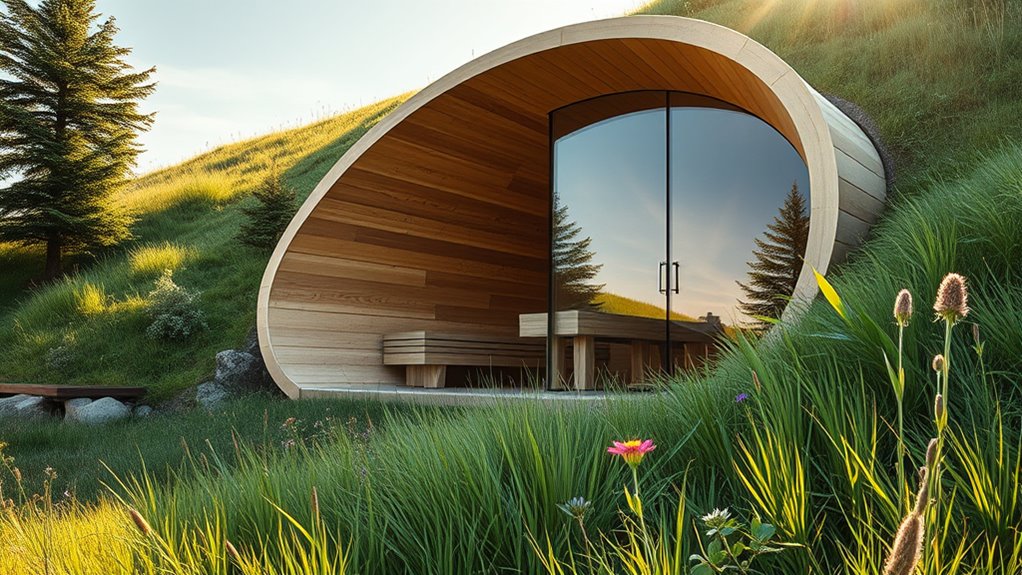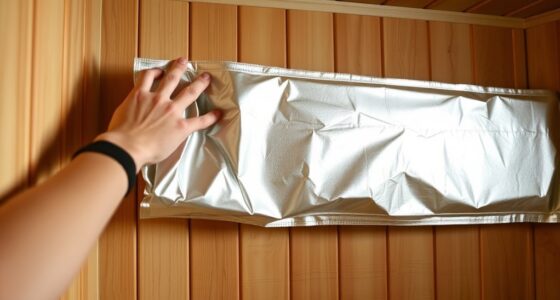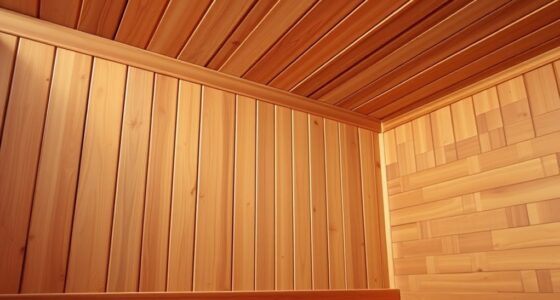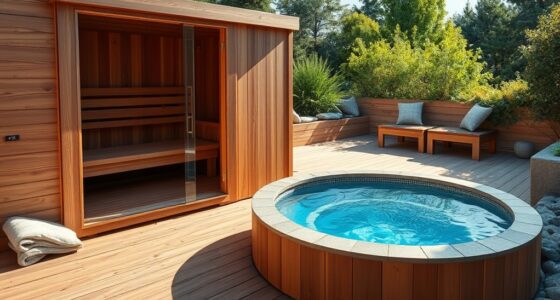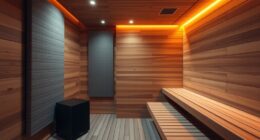To build an earth-sheltered sauna for energy efficiency, start by designing it with earth’s natural insulation in mind, using waterproofing and moisture controls to prevent mold. Incorporate solar collectors for preheating water or air, boosting eco-friendliness, and use soil as a thermal buffer. Proper drainage, ventilation, and structural planning also help maintain stable temperatures and prevent issues. Keep exploring to discover detailed tips for creating a sustainable, low-energy retreat that fits your needs.
Key Takeaways
- Incorporate earth-sheltered design to leverage soil’s insulation and maintain stable internal temperatures.
- Use solar collectors for preheating water or air, reducing reliance on conventional energy sources.
- Install vapor barriers and proper drainage to prevent moisture buildup and protect structural integrity.
- Seal roof and walls effectively to prevent water ingress and promote durability in moisture-prone environments.
- Combine insulation, moisture control, and solar heating for a sustainable, energy-efficient sauna environment.
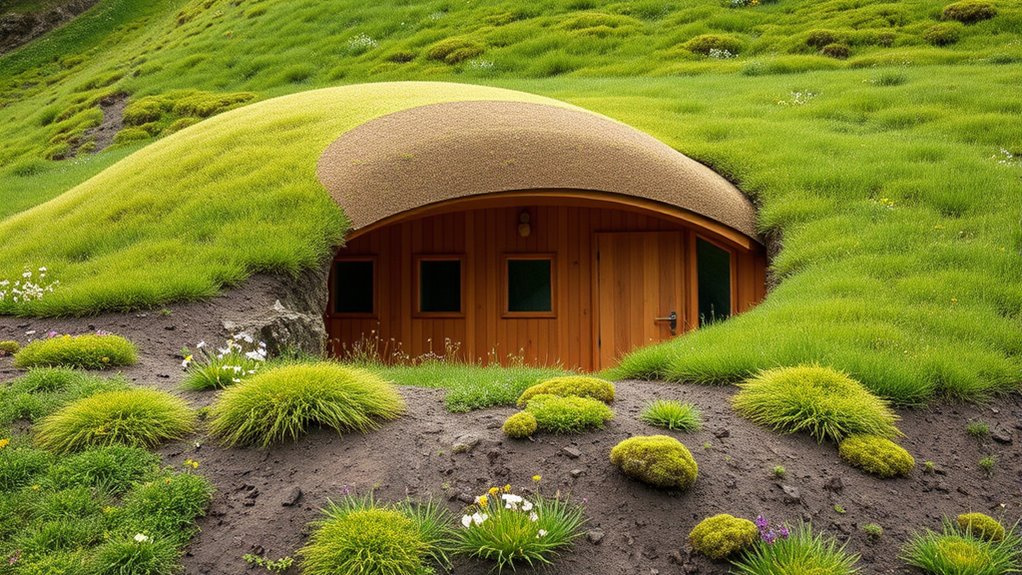
Have you ever considered how an earth-sheltered sauna can provide a natural, energy-efficient retreat? When you build one, you’re creating a space that leverages the earth’s natural insulation properties, reducing the need for external heating and cooling. A key advantage of this design is its ability to work harmoniously with renewable energy sources, like solar heating. By integrating solar collectors into your sauna’s design, you can harness the sun’s energy to preheat water or air, considerably lowering your reliance on conventional power. This method not only reduces your carbon footprint but also cuts down on long-term operating costs. Furthermore, solar heating is particularly effective in an earth-sheltered setting because the surrounding soil acts as a thermal buffer, maintaining consistent temperatures and enhancing the efficiency of your solar system. Proper moisture control is another essential element when constructing an earth-sheltered sauna. Since the structure is partially embedded underground, managing moisture levels prevents issues like mold, mildew, and structural deterioration. You need to ensure proper waterproofing and drainage around your sauna. Installing a vapor barrier beneath the floor and along the walls helps keep moisture out of the interior. Ventilation also plays a crucial role; by incorporating exhaust vents or designed airflow pathways, you can regulate humidity and prevent condensation buildup. These measures keep the sauna environment comfortable and safe, making sure you enjoy your retreat without health concerns or maintenance headaches.
Earth-sheltered saunas optimize insulation and solar heating, reducing energy use and enhancing eco-friendly relaxation.
The soil surrounding your sauna acts as a natural insulator, but it also requires careful planning to optimize moisture control. Choosing well-draining soil and constructing gravel beds or drainage systems around the structure helps divert water away from the foundation. Additionally, a well-sealed roof and walls prevent water ingress that could compromise the interior. Consider incorporating a small overhang or protective canopy over the entrance to shield against rain and snow. These features work together to maintain a dry, stable environment inside your sauna, which is essential for longevity and comfort. Combining solar heating with effective moisture control makes your earth-sheltered sauna a sustainable, low-energy oasis. As you design and build, think about how each element interacts—solar collectors to harness free energy, waterproofing and drainage to prevent moisture issues, and thoughtful ventilation to maintain air quality. Ultimately, your efforts result in a cozy, eco-friendly retreat that minimizes energy consumption while maximizing comfort. With proper planning, you’ll create a durable structure that offers a natural, relaxing escape, all while respecting the environment.
Frequently Asked Questions
What Are the Initial Costs of Building an Earth-Sheltered Sauna?
The initial costs for building an earth-sheltered sauna typically range from $10,000 to $30,000, depending on size, materials, and site conditions. You should do a detailed cost estimation early on to understand expenses. Budget planning helps you allocate funds for excavation, insulation, and finishing. Keep in mind that investing in quality materials may increase upfront costs but improve energy efficiency and durability over time.
How Long Does the Construction Process Typically Take?
You can expect the construction timeline for your earth-sheltered sauna to take roughly 8 to 12 weeks, depending on the project’s complexity and weather conditions. During project planning, you’ll want to allocate extra time for site preparation and permits. Staying organized and working with experienced contractors helps guarantee the process stays on schedule, so you can enjoy your energy-efficient sauna sooner.
What Permits or Regulations Are Required for Underground Saunas?
Did you know that over 60% of underground sauna projects require specific permits? You’ll need to check local zoning requirements and obtain building permits before starting construction. Regulations can vary widely, so contacting your city or county planning department is essential. Make sure your project complies with all codes to avoid fines or delays. Securing these permits early guarantees your earth-sheltered sauna meets safety standards and is legally approved.
How Do You Maintain Indoor Air Quality in an Earth-Sheltered Sauna?
To maintain indoor air quality in your earth-sheltered sauna, you should implement effective ventilation strategies like exhaust fans and passive vents to guarantee fresh air circulation. Regular air quality monitoring helps you detect humidity or pollutant buildup. Keep vents clear of obstructions, and schedule routine checks to sustain ideal air quality, so your sauna remains comfortable, safe, and energy-efficient.
Are There Any Specific Safety Concerns for Underground Sauna Construction?
Yes, there are safety concerns with underground sauna construction. You need to address ventilation concerns to prevent moisture buildup and guarantee proper airflow, reducing mold risk. Additionally, you should focus on structural stability, making sure the walls and roof are reinforced to withstand soil pressure. Regular inspections and proper waterproofing are essential to avoid leaks and structural issues, ensuring your sauna remains safe and durable over time.
Conclusion
Building an earth-sheltered sauna not only boosts energy efficiency but also creates a cozy, natural retreat. Some might worry about insulation or moisture issues, but with proper design, these challenges become manageable. Think of it as carving out a warm haven nestled in the earth’s embrace—you’re blending nature with comfort. This sustainable approach saves energy and adds value to your home. Embrace the process, and enjoy a peaceful, eco-friendly sanctuary all year round.
